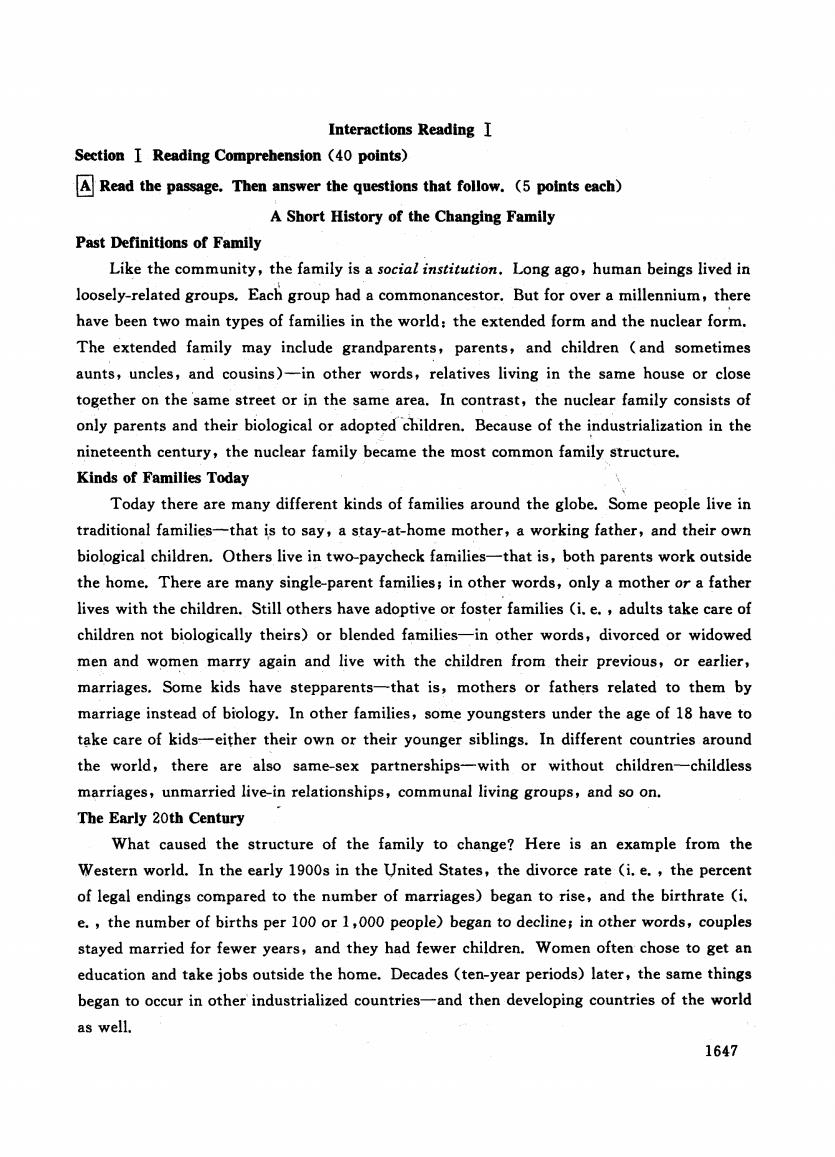正在加载图片...

Interactions Reading I Section I Reading Comprehension(40 points) A Read the passage.Then answer the questions that follow.(5 points each) A Short History of the Changing Family Past Definitions of Family Like the community,the family is a social institution.Long ago,human beings lived in loosely-related groups.Each group had a commonancestor.But for over a millennium,there have been two main types of families in the world:the extended form and the nuclear form. The extended family may include grandparents,parents,and children (and sometimes aunts,uncles,and cousins)-in other words,relatives living in the same house or close together on the same street or in the same area.In contrast,the nuclear family consists of only parents and their biological or adopted children.Because of the industrialization in the nineteenth century,the nuclear family became the most common family structure. Kinds of Families Today Today there are many different kinds of families around the globe.Some people live in traditional families-that is to say,a stay-at-home mother,a working father,and their own biological children.Others live in two-paycheck families-that is,both parents work outside the home.There are many single-parent families;in other words,only a mother or a father lives with the children.Still others have adoptive or foster families (i.e.,adults take care of children not biologically theirs)or blended families-in other words,divorced or widowed men and women marry again and live with the children from their previous,or earlier, marriages.Some kids have stepparents-that is,mothers or fathers related to them by marriage instead of biology.In other families,some youngsters under the age of 18 have to take care of kids-either their own or their younger siblings.In different countries around the world,there are also same-sex partnerships-with or without children-childless marriages,unmarried live-in relationships,communal living groups,and so on. The Early 20th Century What caused the structure of the family to change?Here is an example from the Western world.In the early 1900s in the United States,the divorce rate (i.e.,the percent of legal endings compared to the number of marriages)began to rise,and the birthrate (i. e.,the number of births per 100 or 1,000 people)began to decline;in other words,couples stayed married for fewer years,and they had fewer children.Women often chose to get an education and take jobs outside the home.Decades (ten-year periods)later,the same things began to occur in other industrialized countries-and then developing countries of the world as well, 1647Interactions Reading I 配tion I Reading Comprehension (40 points) ass Th… er qu that follow. (5 poi A Short History of the Changing Family Past Definitions of Family Like the community, the family is a social institution. Long ago , human beings lived in looseiy-relaMgroups.Each group had a commonancestor-But for over a IIlinenniurn ,there have been two main types of families in the world: the extended form and the nuclear form. The extended family may include grandparents, parents, and children (and sometimes aunts, uncles, and cousins)一in other words, relatives living in the same house or close together on thesame street or in the same area. In contrast, the nuclear family consists of only parents and their biological or adoptecCchildren. Because of the industrialization in the nineteenth century, the nuclear family became the most common family Structure. Kinds of Famili臼Today Today there are many different kinds of families around the globe. Some people live in traditional families-that i,s to say , a stay-at-home mother, a working father, and their own biological children. Others live in two-paycheck families-that is, both parents work outside the home. There are many single-parent families; in other words, onlya mother or a father lives with the children. Still others have adoptive or foster families 0. e. , adults take care of children not biologically theirs) or blended families-in other words, divorced or widowed men and women marry again and live with the children from their previous, or earlier, marriages. Some kids have stepparents-that is, mothers or fathers related to them by marriage instead of biology. In other families, some youngsters under the age of 18 have to t~ke care of kids-ei~her their own or their younger siblings. In different countries around the world , there are also same-sex partnerships-with or without children-childless marriages, unmarried live-in relationships, communalliving groups, and so on. The Early 20th Century What caused the structure of the family to change? Here is an example from the Western world. In the early 1900s in the United States, the divorce rate 0. e. , the percent of legal endings compared to the number of marriages) began torise , and the birthrate 0. e. , the number of births per 100 or 1 ,000 people) began to decline; in other words, couples stayed married for fewer years, and they had fewer children. Women often chose to get an education and take jobs outside the home. Decades (ten-year periods) later, the same things began to occur in other industrialized countries-and then developing countries of the world as well. 1647